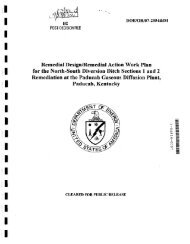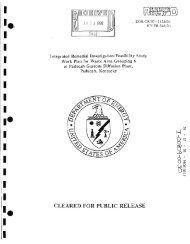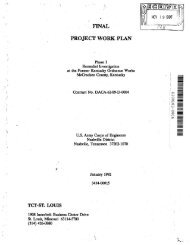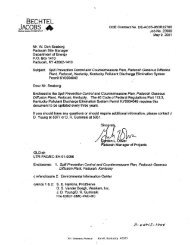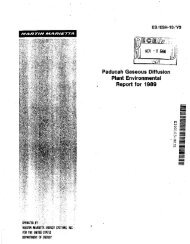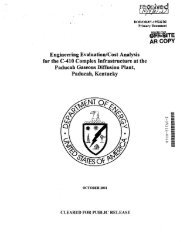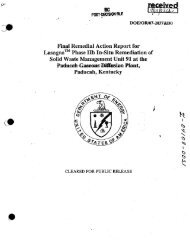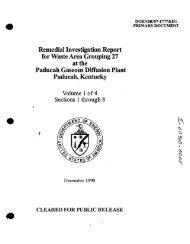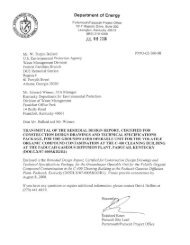1 - paducah environmental information center
1 - paducah environmental information center
1 - paducah environmental information center
Create successful ePaper yourself
Turn your PDF publications into a flip-book with our unique Google optimized e-Paper software.
Annual Site Environmental Report for 1999<br />
Append'ix A: Radiation<br />
This appendix gives basic facts about<br />
radiation, 'This <strong>information</strong> is intended as a basis<br />
for understanding normal radiation dose from<br />
sources unassociated with the Paducah Site. The<br />
McGraw-Hill dictionary defines radiation and<br />
radioactivity as follows:<br />
radiation - 1. The emission and<br />
propagation of waves transmitting energy<br />
through space or through some medium; for<br />
example, the emission and propagation of<br />
electromagnetic, sound, or elastic waves. 2. The<br />
energy transmitted through space or some<br />
medium; when unqualified, usually refers to<br />
electromagnetic radiation. Also known as<br />
radiant energy. 3. A stream of particles, such as<br />
electrons, neutrons, protons, alpha particles, or<br />
high-energy photons, or a mixture of these<br />
(McGraw-Hill 1994).<br />
radioactivity - A particular type of<br />
radiation emitted by a radioactive substance,<br />
such as alpha radioactivity (McGraw-Hill 1994).<br />
Radiation occurs. naturally; it was not<br />
invented, but rather, was discovered. People are<br />
constantly exposed to radiation. For example,<br />
radon ,in air; potassium in food and water; and<br />
uranium, thorium, .and l radium in the earth's crust<br />
are all sources of radiation. The following<br />
discussion describes important aspects of<br />
radiation, including atoms and isotopes; types,<br />
sources, and pathways of radiation; radiation<br />
measurement; and dose <strong>information</strong>.<br />
ATOMS AND ISOTOPES<br />
-All matter is made up of atoms. An atom is<br />
"a unit of matter consisting of a single nucleus<br />
surrounded by a number of electrons equal to the<br />
number of protons in the nucleus" (ANS 1986).<br />
The number of protons in the nucleus determines<br />
an element's atomic number, or chemical<br />
identity. With the exception of hydrogen, the<br />
nucleus of each type of atom also contains at<br />
least one neutron. Unlike protons, the number of<br />
neutrons may vary among atoms of the same<br />
element. The number of neutrons and protons<br />
determines the atomic weight. Atoms of the<br />
same element with a different number of<br />
neutrons are called isotopes. In other words;<br />
isotopes have the same chemical properties but<br />
different atomic weights. Figure A.l depicts<br />
isotopes of the element hydrogen. Another<br />
example is the element uranium, which has 92<br />
protons; all isotopes of uranium, therefore, have<br />
92 protons. However, each uranium isotope has<br />
a different number of neutrons. 234U has 92<br />
protons and 142 neutrons; 235U has 92 protons<br />
and 143 neutrons; and 238U has 92 protons and<br />
146 neutrons.<br />
Some isotopes are stable, or nonradioactive;<br />
some are radioactive. Radioactive isotopes are<br />
called radioisotopes, or radionuclides. In an<br />
attempt to become stable, radionuclides "throw<br />
away" or emit rays or particles. This emission of<br />
rays and particles is known as radioactive decay.<br />
Appendix A<br />
A-1



